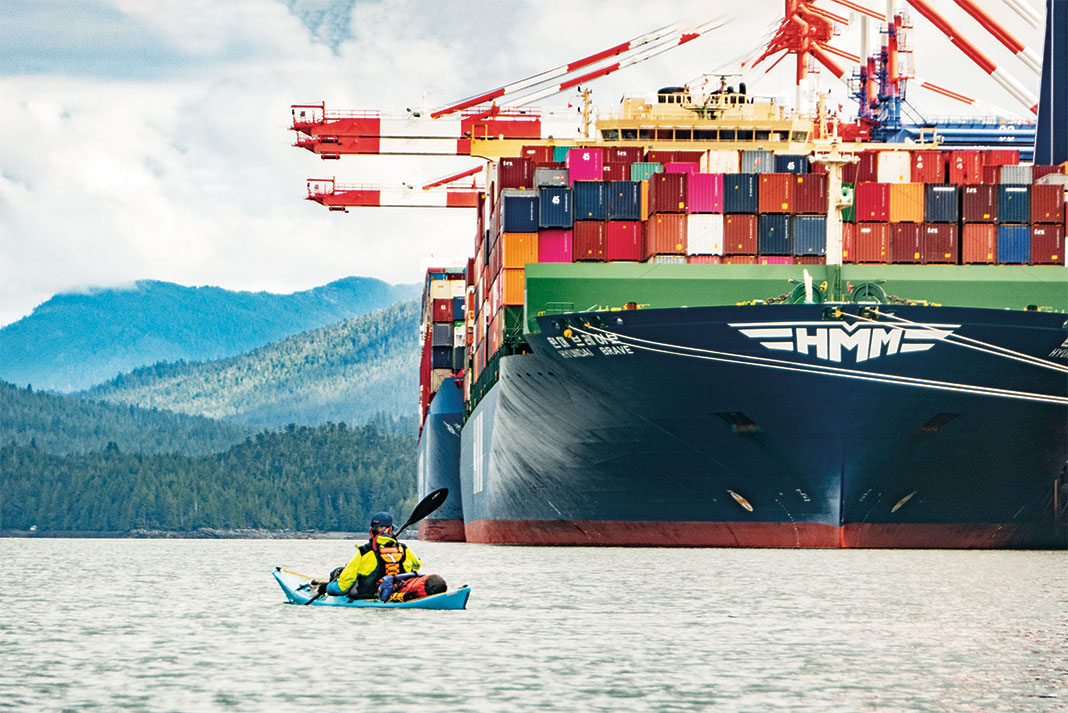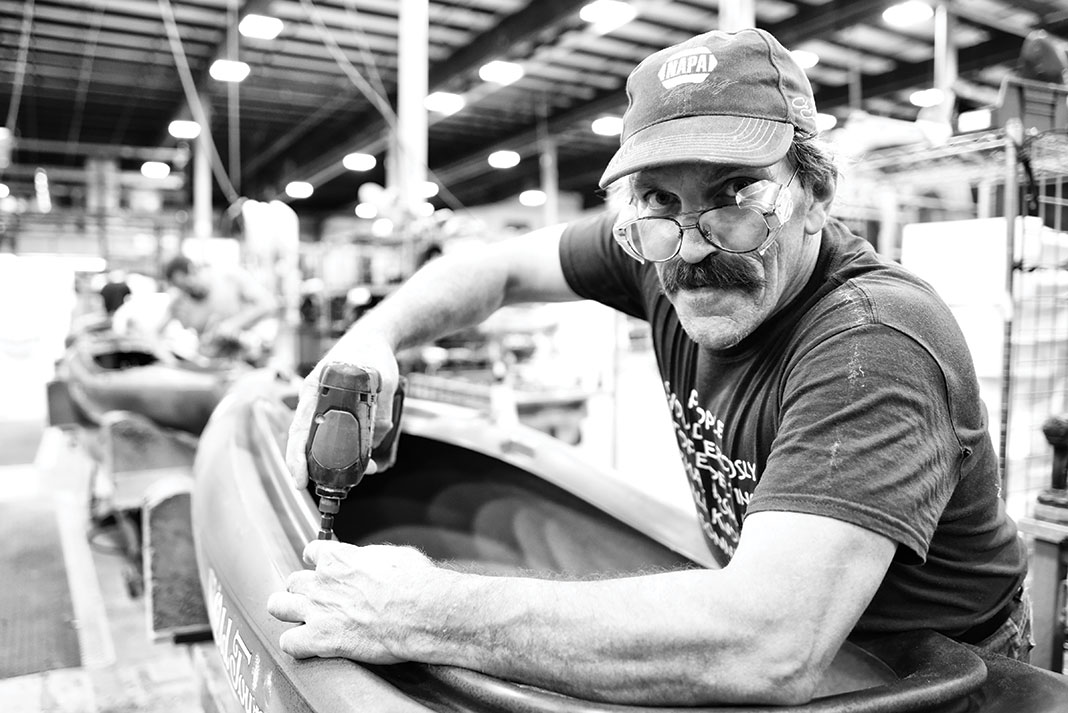The last few years made a pretty strong argument for building paddlecraft right here in North America. First came a trade war ratcheting U.S. import tariffs on kayaks and inflatable boats from China up to as high as 27.4 percent. Then came Covid and a near-total collapse of the global supply chain.
Sticking with the home team was absolutely the right call back then. But how about now?
Beijing Calling
The supply chain is stitched up and seems to be holding together. Shipping is down too. According to the online freight marketplace Freightos, sending a 40-foot container from China to the U.S. west coast this month will cost you less than $1,400, down from a peak of $20,600 in September 2021.
And have you heard about the Chinese economy? It’s gone from bad to worse, meaning Chinese manufacturers are looking to deal like never before.

“The Chinese economy is reeling right now, and that’s going to make those suppliers really sharpen up their pencils,” says Ed Vater, the former Branches president who guided the Wisconsin-based paddlemaker to record profits during the Pandemic, thanks to a relatively short supply chain and an agile homegrown workforce.
When demand shot through the roof in 2020 and 2021 and paddlesports importers could do little more than yell into the phone, Vater walked onto the production floor and started stamping out paddles, alongside his wife and kids. In fact, many Branches employees brought family members on board for what they thought would be a temporary surge in production.
Asian suppliers surged too, but not so quickly. And the products they did manage to produce often sat offshore for weeks in those $20,000 containers. Then, when they finally managed to unload, the taxman was waiting to collect the import duty because nobody has called a truce in the trade war.
All of those factors lined up in favor of domestic manufacturing during the Pandemic, but there are some signs the pendulum is beginning to swing in the other direction.
More than one way to get there
A Made in U.S.A. or Made in Canada badge is good for the brand here in North America, but few consumers choose a boat solely on where it was made. The choice typically comes down to quality and price—factors depending more on a brand’s priorities and management than country of origin.
North America never had a monopoly on quality, and cheap kayaks aren’t only made in Asia. Indeed, the majority of price-point hard-shell kayaks crowding box store shelves are now made on this side of the Pacific. Sun Dolphin molds kayaks in Michigan, Lifetime in Utah and Pelican in Quebec. In our globally integrated world, a better predictor of quality is not where you choose to build, but what you’re willing to pay and how well you manage the process.
Homegrown manufacturing works for Jackson Kayak, which makes whitewater, fishing and recreational kayaks in Sparta, Tennessee, but it may not be the solution for everyone.
Sending a 40-foot container from China to the U.S. west coast this month will cost you less than $1,400, down from a peak of $20,600 in September 2021.
“When it comes down to China versus the U.S., there’s not one right answer or wrong answer,” says Marketing Manager Emily Jackson. Still, having design, production and quality control under one roof can pay dividends in unexpected ways. “We have over 200 people on our team,” Jackson says, and enough of them are boaters that when Jackson Kayak rolls out a new product, someone who punches a clock in the Sparta factory is likely among the first to paddle it. “That really allows us to see the problems faster, not just in the factory but on the water,” Jackson says.
Keeping innovation in-house
There’s also something to be said for keeping an eye on the door, lest your design walk out of it. Or as Vater puts it, “How special is your secret sauce?”
If you’re cooking up something new or different, it may be a good idea to keep a lid on it. That’s more difficult in China, where the culture and law take a more permissive view of intellectual property. Vater offers the hockey stick trade as a cautionary tale.
“Nobody making a hockey stick has really got any technology over anybody else,” says Vater, who in 2002 helped guide Bending Branches out of the hockey business to focus solely on paddles. “When that happens it’s really just marketing and selling a commodity. It’s deadly to brands and nobody invests in the sport anymore,” he says. Two decades on, 75 percent of the hockey sticks used in NHL games are made in China. And the rest? Mexico.
Why I make kayaks in China

“We were producing our Soul Waterman kayaks in China and getting a top-quality product, but a few years ago some of our U.S. customers told us they didn’t want to buy Chinese-made kayaks. They wanted to buy American-made kayaks, and they were vocal enough that we decided to do it.
We found a factory in the U.S. that sold us on their ability to make quality products and shipped all our molds to them—our whole production facility. A month and a half into it, they’re like, “Dude, we can’t make your boats. You either need to drop your standards or redesign them so they’re easier to make.”
I wasn’t about to do either of those things, so I moved to a factory in Canada. Same thing. Then I moved to another factory in the U.S., and then another, and it was the same with them. So finally I just moved everything back to China.
My supplier there said, “Tell us what you want and what your standards are. We’re going to charge you for it, but we’ll make it.”
The days of cheaper manufacturing in China are in the past. It costs me about 20 percent more to produce in China than the U.S. But I get the quality I want, and I get it on time.
Chinese goods have a bad reputation because people have long memories, and the stuff that was coming out of China 30 years ago was absolute rubbish. That’s no longer the case. I know because I’ve been making things in China for three decades and have seen the change in quality over that time.
The second part of that equation is, if you go to a dollar store and buy an item for a dollar and it breaks three days later, the reason it broke was not because it was made in China. It broke because it cost a dollar. What did you expect?
There are still factories in China that make dollar store junk. But your iPhone was made in China, and your laptop was made in China. The computer chips that are in your Maserati are made in China.
You don’t go to China to produce cheap stuff anymore. You go to China because the supply chain is there. Somebody in China makes every widget you need to build whatever you can imagine building, and the entire country is set up to get that widget to you as cheaply and as efficiently as possible. And then the infrastructure is in place to get your finished product onto a boat and on its way to your customers.
In fact most companies producing in North America use components that are made in China. If you’re going to wait for critical parts you need to come from China to build your product, you might as well build the whole thing there, which gives you flexibility as well as quality.”
— by Corran Addison, as told to Jeff Moag
 This article was first published in the 2024 issue of Paddling Business. Inside you’ll find the year’s hottest gear for canoeing, kayaking, whitewater and paddleboarding. Plus: how to beat the big box, trends in kayak fishing instruction, building the Paddlesports Trade Coalition and more. READ IT NOW »
This article was first published in the 2024 issue of Paddling Business. Inside you’ll find the year’s hottest gear for canoeing, kayaking, whitewater and paddleboarding. Plus: how to beat the big box, trends in kayak fishing instruction, building the Paddlesports Trade Coalition and more. READ IT NOW »
Wherever you choose to go, there’s more than one way to get there. | Feature photo: Frank Wolf












There are those who think the import, export door with China will never slam shut. It will, and those folks who run these so called American company’s will be crying like a bunch of spoiled babies when it does. Fifty years of Globalization has made this country stupid and weak. But who cares, it’s another personal right to spend one’s money however we see fit.